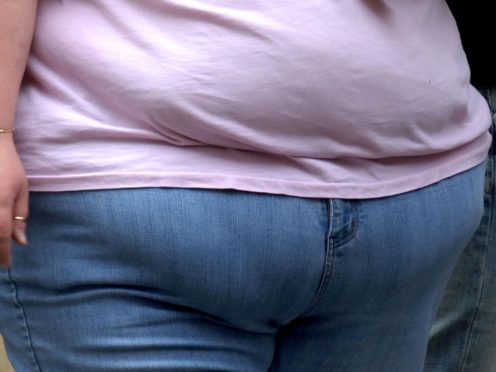
Being obese is linked to a significantly higher chance of serious disease and early death than being a healthy weight, research on more than 2.8 million adults suggests.
The chance of suffering serious illness goes up with increasing weight gain, experts analysing health, death and sickness data from UK adults found.
Presented at the European Congress on Obesity (ECO) in Glasgow, the study found that people with a body mass index (BMI) of 30 to 35 were at 70% higher risk of developing heart failure than their healthy weight peers.
Even a BMI of 25 to 30 increased the risk by 20%, while a BMI of 35 to 40 more than doubled the risk and a BMI of 40 to 45 almost quadrupled the risk compared to people of a normal weight.
The study also found that compared with normal weight individuals, a BMI of 25 to 30 increased the risk of Type 2 diabetes and sleep apnoea by more than double, while a person with a BMI of 30 to 35 was more than five times as likely to develop Type 2 diabetes and almost six times as likely to develop sleep apnoea.
For those with a BMI of 35 to 40, the risk of Type 2 diabetes was almost nine times higher, and 12 times higher for sleep apnoea.
People with severe obesity (BMI of 40 to 45) were 12 times more likely to develop Type 2 diabetes and had a risk of sleep apnoea that was 22 times greater.
The results also showed that increasing weight was linked to higher risk of high blood pressure, irregular heartbeat and dyslipidaemia (abnormal levels of cholesterol and other fats in the blood).
People with a BMI of 40 to 45 had triple the risk of heart failure, high blood pressure, and dyslipidaemia.
This BMI was also linked to a 50% higher risk of dying prematurely from any cause compared to people of a normal weight.
The research found that the risk of developing serious health problems was highly dependent on whether or not people already had issues at the start of the study.
For example, having high blood pressure at the start of the study was strongly associated with developing dyslipidaemia, chronic kidney disease and Type 2 diabetes.
Researchers looked at health, death and BMI data from more than 2.8 million adults between January 2000 and July 2018 from the UK Clinical Practice Research Datalink.
This was linked with hospital data to estimate the risk for serious health problems.
Author Christiane Haase, from Novo Nordisk in Denmark, which funded the study, said: “The health risks linked with having excess body weight are particularly high for Type 2 diabetes and sleep apnoea.
“With the number of people living with obesity almost tripling worldwide over the past 30 years (105 million people in 1975 to 650 million in 2016), our findings have serious implications for public health.”
The research was presented as a poster at the conference and was peer-reviewed by the conference selection committee.
Naveed Sattar, professor of metabolic medicine at the University of Glasgow, said: “This study serves to remind us, once again, how damaging obesity is given its strong associations with a range conditions beyond diabetes and heart disease.
“The obesity links to heart failure are becoming more widely appreciated and links to sleep apnoea, hypertension and abnormal blood fats are well known.
“Like most observational BMI studies using routine health data, there are limitations to this work but I suspect some risks are in fact underestimated.
“The health profession needs to up its game in helping people improve their weight (there are good signs that it is doing so) as it is unlikely that the food environment is going to drastically improve anytime soon.”
Dr Emily Burns, head of research communications at Diabetes UK, said: “It’s important to note the significantly increased risk of Type 2 diabetes suggested by this research – while alarming – was specifically seen in people with a very high BMI of over 40, which only accounts for 2% of men and 5% of women in England.
“That said, we know that being overweight increases your risk of developing Type 2 diabetes.
“Losing weight can be tough, but programmes such as NHS England’s Diabetes Prevention Programme are there to help people at high risk, and the Diabetes UK website has ideas for healthy meals, ingredient swaps and tips on getting active too.”
Louis Levy, head of nutrition science at Public Health England (PHE), said: “Most countries are facing increasing levels of obesity, putting pressure on both individuals’ health and national health and social care systems.
“To reverse what’s been decades in the making needs sustained action across the drivers of poor diets and weight gain.
“We’re working with industry to make food healthier, we’ve produced guidance for councils on planning healthier towns and we’ve delivered campaigns encouraging people to choose healthier food and lead healthier lives.”
Victoria Taylor, nutrition lead at the British Heart Foundation, said: “It’s a well-known fact that obesity is one of the factors that can seriously increase your risk of developing heart and circulatory diseases, as well as Type two diabetes.
“Despite this, more than a quarter of UK adults (28%) are obese and it’s something that we urgently need action on.
“This should include changes that make it easier for all of us to make healthier food choices and be more active, and a continued focus on the reformulation of foods to make our everyday groceries more healthy.
“More responsible advertising and marketing of foods to children should also be part of the solution.”

Enjoy the convenience of having The Sunday Post delivered as a digital ePaper straight to your smartphone, tablet or computer.
Subscribe for only £5.49 a month and enjoy all the benefits of the printed paper as a digital replica.
Subscribe